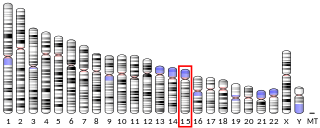
Ubiquitin-conjugating enzyme E2 G2 is a protein that in humans is encoded by the UBE2G2 gene.

Protein deltex-2 also known as E3 ubiquitin-protein ligase DTX2 is an enzyme that in humans is encoded by the DTX2 gene.

E3 ubiquitin-protein ligase NRDP1 is an enzyme that in humans is encoded by the RNF41 gene.

Ubiquitin-conjugating enzyme E2 E2 is a protein that in humans is encoded by the UBE2E2 gene.

RING finger protein 37 is a protein that in humans is encoded by the UBOX5 gene.

E3 ubiquitin-protein ligase Praja1 is an enzyme that in humans is encoded by the PJA1 gene.

E3 ubiquitin-protein ligase UHRF2 is an enzyme that in humans is encoded by the UHRF2 gene.

E3 ubiquitin-protein ligase SHPRH is an enzyme that in humans is encoded by the SHPRH gene.

Putative E3 ubiquitin-protein ligase SH3RF1 is an enzyme that in humans is encoded by the SH3RF1 gene.

E3 ubiquitin-protein ligase RNF25 is an enzyme that in humans is encoded by the RNF25 gene.

The E3 ubiquitin-protein ligase Hakai (HAKAI) also known as Casitas B-lineage lymphoma-transforming sequence-like protein 1 (CBLL1) is an enzyme that in humans is encoded by the CBLL1 gene. This gene encodes an E3 ubiquitin ligase for the E-cadherin complex and mediates its ubiquitination, endocytosis, and degradation in the lysosomes. The encoded protein contains a RING-finger domain and is also thought to have a role in control of cell proliferation.

Ring finger protein 26 is a protein that in humans is encoded by the RNF26 gene.

Zinc finger protein 426 is a protein that in humans is encoded by the ZNF426 gene.

Tripartite motif containing 69 is a protein that in humans is encoded by the TRIM69 gene.

Ring finger protein 19B is a protein that in humans is encoded by the RNF19B gene.

Listerin E3 ubiquitin protein ligase 1 (LTN1), otherwise known as listerin, is a protein that in humans is encoded by the LTN1 gene.

Ring finger protein 43 is a protein that in humans is encoded by the RNF43 gene.

Tripartite motif containing 38 is a protein that in humans is encoded by the TRIM38 gene.

Ring finger protein 167 is a protein that in humans is encoded by the RNF167 gene.

UFM1 specific peptidase 2 is a protein that in humans is encoded by the UFSP2 gene.



















